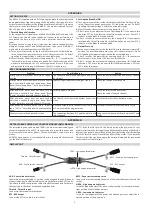
THRUSH AIRCRAFT, INC – MODEL S2R-R1340
AIRCRAFT MAINTENANCE MANUAL
Effective: 01/01/08
2-5
For example:
Existing weight = 4,723#
Existing C.G. = 25.43”
Existing moment = 4723 x 25.43 =
120,106 in.#
Added equipment weight = 17#
C.G. of equipment = -23.5 (ie. forward
of wing leading edge)
Moment change = 17 x (-23.5) =
- 400 in.#
New weight: 4,723 + 17 = 4,740#
New moment: 120,106 – 400 =
119,706 in.#
New C.G.: 119706
÷
4740 = 25.25”
(aft of datum)
Weighing the Airplane
New weight and C.G. due to large weight
changes, installations that are difficult to
determine the C.G. of, or multiple small
changes should generally be determined
by re-weighing the airplane.
The airplane must be in a ready to fly
condition during weighing, except that the
fuel tanks may hold unusable fuel (1.5
GAL. per side).
Three scales will be needed for this
operation: two with about a two ton
capacity and one with a half ton capacity.
These scales need to be in good condition
and calibrated within the past year.
The two large scales are placed under the
MLG tires, and the small scale is placed
under the tailwheel. The airplane must be
level during this process (see LEVELING,
above), which will require a tail stand. The
new weight is simply the total of the three
scale readings, unless the tail stand had to
be placed on the rear scale. If this was
done, the weight of the tail stand and any
shims must be subtracted from the aft
scale reading. This is not necessary if the
scale was between the tailwheel and the
stand.
The new moment is the sum of the main
gear scale readings multiplied by 3.10”
(the distance the MLG axles are behind
the wing leading edge) plus the rear scale
reading (adjusted for tare as necessary)
multiplied by 233.13”. The new empty
weight C.G. is the total moment divided by
the total weight.
For example:
Left MLG scale reading = 2,127#
Right MLG scale reading = 2,105#
Tailwheel scale reading = 472#
Tare weight (ie. tail stand and shims if
placed on top of the scale) = 65#
New empty weight: 2127 + 2105 + 472
– 65 = 4,639#
New moment: (4232 x 3.1) + (407 x
233.13) = 108,003 in.#
New C.G.: 108003
÷
4639 = 23.28”
COLD WEATHER OPERATION
Aircraft operation in cold weather creates a
need for additional maintenance practices
and operating procedures that are not
required in moderate temperatures.
Whenever possible, shelter the aircraft in a
heated hangar to prevent frost, ice, or
snow accumulation that requires added
maintenance time to remove. These
weather elements, if allowed to
accumulate only a fraction of an inch in
thickness on the critical airfoils and control
surfaces, seriously degrade aircraft lift and
flight control effectiveness. The possibility
of aircraft system failures is increased
when the aircraft is parked where wind
driven snow or freezing rain can be forced
into various openings of the aircraft. If the
aircraft is to be moored outside in extreme
cold, the battery should be kept fully
charged to prevent freezing. Make certain
that all vents, air inlets, and so forth are
covered.









































